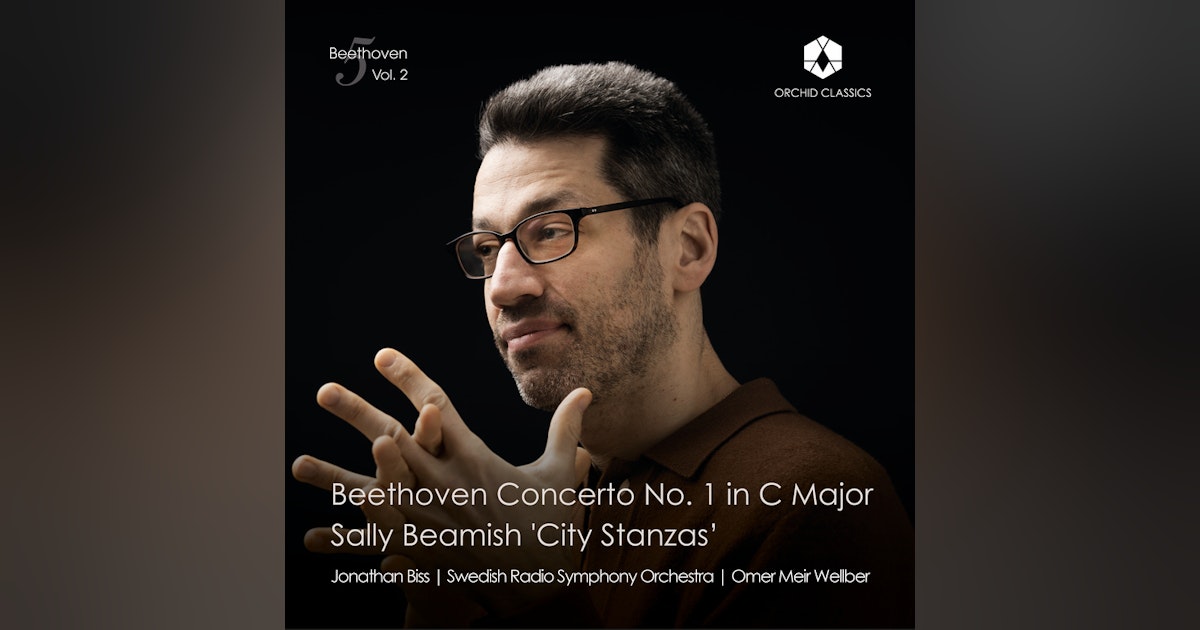
At his finest, Jonathan Biss is up there in the very top echelon of pianists. His speciality is Beethoven, a composer on whom he speaks and lectures as well as plays. We met his Orchid Classics Beethoven cycle before, when, in Volume 1, Beethoven’s Fifth Concerto was coupled with Brett Dean (A Winter’s Journey.
Welcome to Volume 2, which takes us to the other end (in numerical order: No. 1 was actually the second in composition order of the five numbered concertos). Since that pervious post, we have met the conductor, Omer Meir Welber, at the Southbank with the London Philharmonic, and in what I described as “one of the finest Butterflies available,” from Glyndebourne.
Biss plays the third of Beethoven’s three cadenzas to the first movement of the First Concerto, and brilliantly, allowing it to blossom out from the opening two-part counterpoint to arpeggiations of gruff grit. Biss’ clarity, too, is perfect, as his his equally Beethovenian sense of humour – which later meets volcanic choral eruptions. Beethoven covers huge territory in this movement, and so do Biss and Welber; the cadenza is like the movement in microcosm, but in a volatile mood. The Swedish Radio Symphony Orchestra is in fine fettle throughout. too:
The Largo is glorious; the Swedish orchestra’s woodwind players are exceptional, as is Welber’s connection with Biss: the connections between orchestral and piano plateaux are impeccable. at times, too Biss plays as if improvising, and the effect is truly magical: :
The finale is one of Beethoven’s most infections, and positively fizzy here. Again, it’s that rapport between Biss and Welber that creates the success. The orchestral texture ar as carefully calibrated as the piano’s. Now, of course, the woodwind turn from the lyrical to the playful, If I find Biss’s cross-hand registrar shifts less characterful than some, his cadenza is exceptional, and his timing of the shift within the closing trill is perfect:
A fine Beethoven First: one that would grace anyone’s collection. The live provenance gives it that extra edge.
We have met Salle Beamish on several previous occasions: The King’s Alchemist, a variation on “Lovely Joan” (Presteigne Premieres, Resonus) ; also, the music has been featured at the London Piano Festival, and in the podcast A Land Without Music.
Here, we have City Stanzas, written for Jonathan Biss, Beamish’s Piano Concerto No. 3. Beamish’s first two concertos reference the natural world; this one is urban in inspiration. The intent was initially to offer a tribute to human creativity (most explicitly via Beethoven’s First Concerto), but political environments in both UK and USA affected the basis of the work. Particularly troubling to Beamish was the basis of greed she perceived; all there movements of her Third Concerto are “darkly sardonic”. The first movement is a “circus-like toccata,” intervals angular like some St Vitus’ dance. Beamish herself descibes this as a “circus-like toccata”; the central section offers beauty (she simply describes it as “more relaxed,” which strikes me as under-selling her own wares: is both lovely and thoughtfully constructed). The movement as a whole is aptly entitled, “Burlesque”:
Bulesques are not traditionally juxtaposed with requiems, but such is the case here: “Requiem” is a depiction of urban decay (which can easily engender loneliness) This movement is “a memorial for those who die alone in the midst of the city“. The beginning is so quiet you might have to turn the volume up: low percussion ceding to eerie bass clarinet. But perhaps it is the piano’s entrance, a sequence of chords, that really carries the weight. There is more than a hint of a funerary procession here, not least in the muffled drumbeat around 5″50:
Nowhere is the lnk between Beethoven and Beamish so clear than in the finale, “Rondo”. This is Beethoven through a grotesque mirror, again with a toccata undercurrent. I like the composer’s own descriptions of her workings with Beethoven’s material as offering a sot of “queasy irony”. Toccatas, of course, play to Biss’ strength of clarity of finger and texture … and Beamish’s invention is perfectly sculpted within the rondo format. A big band meets shrieking strings in positively Charles Ivesian fashion at one point; and the way the performance melds exactitude with festivity is miraculous:
It is amazing to think these are live performances (Berwaldhalle, Stockholm, Sweden, over three days in December 2018). One of Jonathan Biss’ finest releases.
There’s only one copy left in stock at Amazon at the time of writing, and it’s lessthan a tenner, so do snap it up here.










